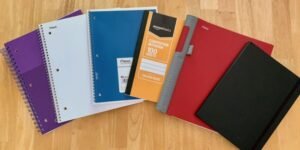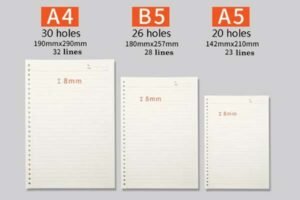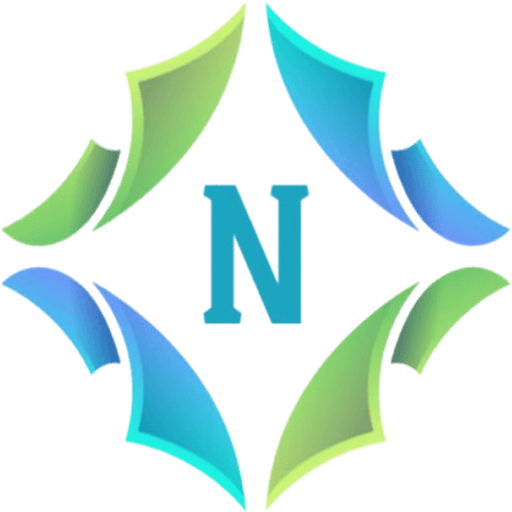
Are you wondering who actually buys notebooks in today's digital world? It's easy to assume they're less popular, but that could mean missing key customers. Understanding the diverse groups who rely on notebooks is essential for success.
Notebooks are bought by a wide range of people, mainly students for learning, professionals for work organization, creatives for ideas, and individuals for journaling or hobbies. These core groups value the tactile experience of writing.
As someone who's been in the notebook manufacturing business since 2006 with NotebookRing®, I've seen firsthand how notebooks continue to thrive. Different people need notebooks for very different reasons. It's not just one type of person. It ranges from young students taking class notes to executives planning projects, and artists sketching designs. The common thread is the need for a simple, reliable tool to capture thoughts, plans, or information.
This diverse appeal means notebooks are far from obsolete. Students need them for coursework and studying. Professionals use them for meeting notes, task management, and brainstorming. Creative individuals rely on them for sketching, drafting, and capturing inspiration. Plus, many people use notebooks for personal journaling, planning hobbies, or keeping diaries. Each group has unique preferences for size, paper style, and binding.
How do different age groups use notebooks?
The way people use notebooks often changes with age. It's interesting to see how needs evolve.
Younger groups like students (Gen Z, Millennials) often use notebooks for structured learning and notes. Professionals (Millennials, Gen X) use them for work tasks and planning. Older adults may use them more for hobbies, journaling, or memory keeping.

Let's look closer at how different generations interact with notebooks. Usage patterns clearly shift based on life stage and daily activities. Understanding these differences helps us at NotebookRing® design products that truly fit various needs.
Students (Primarily Gen Z & Younger Millennials)
This group needs notebooks mainly for school. They take lecture notes, solve problems, and organize study materials. Durability is important because notebooks get carried around a lot. Affordability is also a big factor.
- Common Uses: Class notes, homework, study guides.
- Preferences: Ruled paper, spiral binding (to lay flat or fold back), sturdy covers, standard sizes (like A4 or Letter). Cost-effectiveness is key for bulk buying.
Professionals (Primarily Millennials & Gen X)
Working adults use notebooks for organization and productivity. Meeting notes, to-do lists, project planning, and brainstorming are common uses. They often prefer a more polished look and higher quality materials.
- Common Uses: Meeting minutes, action items, project outlines, bullet journaling.
- Preferences: Quality paper (80gsm+), lay-flat binding (like sewn bindings), professional aesthetics (minimalist covers, perhaps leatherette), often A5 or B5 sizes for portability. Customization with company logos is popular for corporate gifts, something we frequently handle.
Creatives (Spans Multiple Age Groups)
Artists, writers, designers, and other creative individuals use notebooks as tools for their craft. Sketching, drafting ideas, storyboarding, and mind-mapping are typical activities. Paper quality and format are critical.
- Common Uses: Sketching, ideation, writing drafts, mood boards.
- Preferences: Blank or dot-grid paper, specific paper weights or types (like thicker sketch paper or smooth paper like Tomoe River for fountain pens), lay-flat bindings are essential. Unique sizes or custom formats might be needed.
Older Adults (Boomers & Silent Generation)
This demographic might use notebooks for personal journaling, managing households, hobbies, or preserving memories. Simplicity, readability, and ease of use are often prioritized.
- Common Uses: Journaling, recipe keeping, gardening logs, tracking appointments, writing letters.
- Preferences: Clear ruling, durable but simple covers, standard sizes that are easy to handle. Sometimes larger print or line spacing is helpful.
Here's a simple table summarizing these general tendencies:
| Age Group | Primary Use Context | Common Notebook Preferences |
|---|---|---|
| Students | Education | Durable, Affordable, Spiral/Ruled, Standard Sizes |
| Professionals | Work/Productivity | Quality Paper, Lay-Flat, Professional Look, A5/B5, Custom |
| Creatives | Art/Ideation | Specific Paper (Blank/Dot), Lay-Flat, Quality Construction |
| Older Adults | Personal/Hobbies | Simple, Readable, Durable, Standard Sizes, Clear Ruling |
What notebook features appeal most to specific demographics?
Beyond age, specific features attract different user groups. It's not just about the paper, but the whole package.
Students often prioritize durability and price, while professionals look for premium paper and covers. Creatives need specific paper types and bindings like lay-flat. Eco-conscious buyers value sustainable materials and certifications like FSC.

Matching features to the right demographic is key for manufacturers like us and for businesses choosing notebooks for their teams or customers. Let's break down which features resonate most with different users based on what we've learned over 18 years at NotebookRing®.
Feature Focus: Students
Students need notebooks that can survive backpacks and daily use. Functionality over fancy features is typical.
- Key Needs: Tear-resistant covers, strong binding (spiral often preferred for ease of use), standard ruling, price point suitable for buying multiples. Tear-out pages can be a plus for assignments.
- Our Solution: We offer bulk options for educational institutions with reinforced bindings and durable covers, keeping costs manageable.
Feature Focus: Professionals
Professionals often view their notebook as part of their professional image. Quality and functionality for meetings and planning are paramount.
- Key Needs: High-quality paper (80-120gsm acid-free) to prevent ink bleed-through, sophisticated cover materials (PU leather, linen), lay-flat binding for easy writing, options for customization (like logo embossing or hot stamping).
- Our Solution: Our expertise includes various cover processes ($0.08-$0.15/unit) and paper upgrades (e.g., 80gsm to 100gsm for +$0.07/book), along with providing professional binding options.
Feature Focus: Creatives
This group has very specific needs based on their medium. The paper and binding interaction is crucial.
- Key Needs: Paper variety (blank, dot grid, grid, sketch paper like European types), specific paper weights, binding that allows the notebook to lay completely flat (sewn binding, some spiral types, discbound compatibility), sometimes unique sizes or formats.
- Our Solution: We provide a wide range of paper selections, including Japanese Tomoe River and sketch paper, and binding methods like sewing glue binding which allows for a 180° flat design, as seen in our German bookstore case.
Feature Focus: Eco-Conscious Consumers
A growing number of consumers across demographics prioritize sustainability.
- Key Needs: Recycled paper, FSC™ certification (showing responsible sourcing), soy ink printing, biodegradable or recycled cover materials (like bagasse fiber or degradable PP).
- Our Solution: We are FSC™ certified (C106904) and offer recycled paper options at no surcharge, soy ink printing, and innovative eco-friendly materials. We even plant a tree for every 100 books sold.
Here's how features align with needs:
| Demographic | Crucial Features | Why It Matters | NotebookRing® Capability |
|---|---|---|---|
| Students | Durability, Affordability, Standard Ruling/Spiral | Daily wear & tear, budget constraints | Bulk production, reinforced bindings, cost-effective options |
| Professionals | Paper Quality, Professional Cover, Lay-Flat Binding | Ink handling, Image, Ease of use in meetings | 80-120gsm paper, Custom covers (hot stamp, laser), Sewn binding |
| Creatives | Paper Type (Blank/Dot), Lay-Flat, Specific Sizes | Medium suitability, Unhindered drawing/writing | Diverse paper stock, 180° lay-flat binding, Customization |
| Eco-Conscious | Recycled/FSC Paper, Sustainable Materials, Certs | Environmental impact, Ethical sourcing | FSC™ (C106904), Recycled paper, Soy ink, Eco covers |
Why is understanding notebook buyer demographics1 crucial for businesses?
Knowing who buys notebooks and why isn't just academic. For a business like mine, or for companies buying notebooks as gifts or supplies, this knowledge is critical.
Understanding your target demographic helps you design the right products, market them effectively, choose appropriate partners, and ultimately satisfy customer needs better, leading to improved sales and loyalty.

Thinking about demographics impacts every step, from initial design to final sale. It helps us avoid guesswork and make smarter decisions. [Insert brief personal story here about a time understanding a specific customer need led to a successful product].
Tailoring Product Development
Knowing if you're targeting students versus executives directly impacts design choices. For example, a request like Sarah Müller's (German bookstore chain) for FSC-certified notebooks with specific indexing requires understanding the European educational market's needs and regulations. James Wong's need for small-batch, logo-engraved metal binders for corporate gifts points towards the professional market's desire for customization and smaller, flexible order quantities.
- Action: Use demographic insights to select appropriate materials, binding, ruling, size, and cover art.
Focusing Marketing and Sales Efforts
You wouldn't market a high-end leather journal the same way you'd market a basic composition book. Understanding demographics tells you where to reach potential customers (e.g., education fairs for student notebooks, business expos for corporate gifts, art supply stores for creative journals) and what message will resonate.
- Action: Align marketing channels and messaging with the target demographic's habits and values.
Building Strategic Partnerships
Knowing who uses certain types of notebooks helps identify potential collaboration opportunities. For instance, partnering with tech companies (like our Silicon Valley client) for onboarding kits, or with designer brands (like our Japanese client) for unique stationery items, works best when you understand the end-user.
- Action: Seek partners whose audience aligns with a specific notebook-using demographic.
Staying Competitive and Innovative
Customer preferences change. Younger generations might demand more tech integration features, while eco-consciousness grows across all groups. Tracking demographic trends helps businesses like NotebookRing® adapt and innovate, like developing our patented "seamless coil" or offering more sustainable options.
- Action: Continuously monitor demographic trends and adapt product offerings and manufacturing processes accordingly.
Finding the Right Manufacturing Partner Matters
Understanding who buys notebooks is the first step. The next crucial step, especially if you're a business looking to source notebooks, is finding a manufacturer who understands these nuances and can deliver precisely what your target demographic needs.
This is where we, NotebookRing®, come in. Since 2006, we've focused exclusively on crafting high-quality notebooks and binders. Our 15,000㎡ FSC-certified factory isn't just about scale (producing 500,000+ notebooks monthly); it's about precision and flexibility.
We serve diverse markets, from European bookstores needing eco-certified products to Silicon Valley tech firms wanting custom onboarding kits, and Japanese brands developing niche stationery. Our vertical integration—controlling everything from paper processing to metal stamping—allows us to maintain quality (ISO 9001, BSCI audited) and offer competitive pricing (starting from $0.63-$1.70 depending on volume).
Whether you need:
- Deep Customization: Hot stamping, laser engraving, embossing, special paper (Tomoe River, recycled), unique bindings, specific sizes (A5, B6, passport).
- Quality Materials: Acid-free paper, durable metal rings (304 stainless steel), eco-friendly options (bagasse fiber, soy ink).
- Flexibility: Support for sample orders (100 units) up to large batches, with reliable global logistics (30-day standard delivery, faster options available).
- Proven Experience: Successfully serving demanding clients in Europe, the US, Japan, and Korea.
If you're looking for a partner who understands the market and delivers quality, I invite you to reach out.
Contact Timothy Wei at info@notebookring.com or visit www.notebookring.com. We offer free physical sample books and respond to inquiries within 24 hours. Let's create the perfect notebook for your needs.
Conclusion
Notebooks remain popular across diverse groups like students, professionals, and creatives. Understanding their specific needs and preferences is key for anyone making, selling, or buying notebooks. This knowledge ensures the right product reaches the right hands.
-
Exploring this resource will provide insights into the demographics that shape notebook purchasing decisions, helping businesses tailor their strategies effectively. ↩





